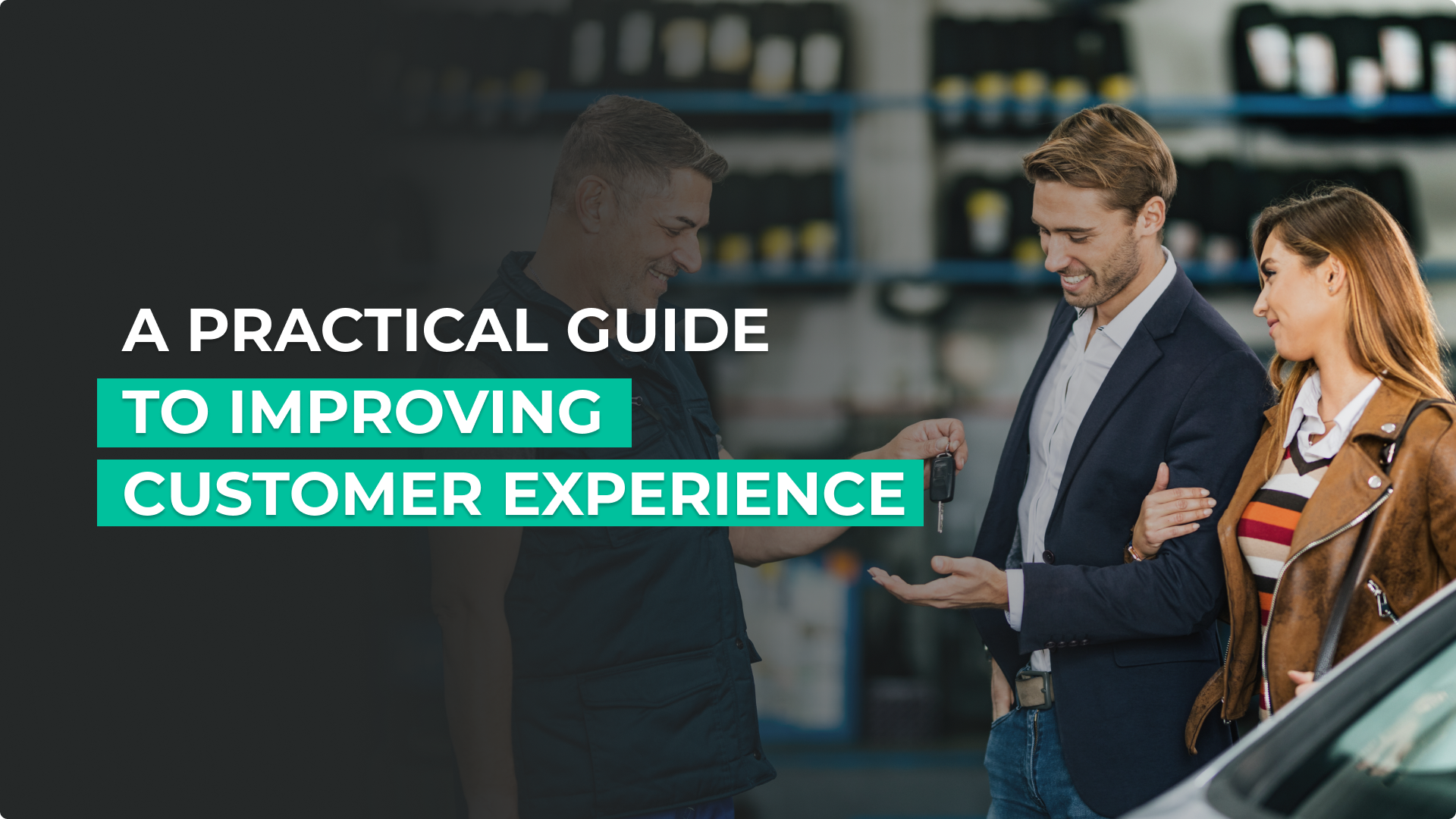Customer interactions with businesses and how they buy cars are rapidly evolving. The average car buyer spent fifteen hours looking for the ideal vehicle in 2022. Today, the duration grew. Why? Before they even walk in, customers now spend hours researching prices and reading reviews online.
This means that dealerships and service centers can no longer rely solely on face-to-face support. Regardless of how they buy or through which channels, consumers today expect a complete experience.
What if you fail to deliver? For instance, nearly 37% of consumers say they have switched brands because a competitor offered a better experience, per a 2023 PCW study. Read through the blog and ensure your automotive business serves their customers right.
What is customer experience?
The sum of a customer’s interactions with your brand is known as the customer experience (CX). From the first time they see it until long after they have signed up as a customer. When done right, it builds loyalty, trust, and sets you apart from the competition. CX is not a singular event. There are several parts to it:
Mapping the customer journey
So start by stepping into the shoes of your customers. Mapping the journey allows all touchpoints, from initial website visit to ongoing purchases, to be examined.
Visiting an auto shop might involve, for example: searching for repair services online, calling to find out if they are available, setting up an appointment, delivering the car and picking it back up, and receiving care subsequently.
By mapping these steps, you can see at what point in time slippage or confusion happens and how to fix it.
Personas of customers
Personas are fictional representations of your ideal clients. For instance, in the case of an auto shop:
- Buyer on a tight budget who will shop around to find the best deal.
- Busy professional who appreciates clear updates and a quick turnaround.
- People who appreciate cars but need a professional to help them select and service them with the highest quality.
Personas allow your team to step into the shoes of these people and understand what they dream, what they hate, and why, all in all, you will help them.
Brand strategy
It’s not just a logo. Your brand is what you promise your customers. Linking your values to what your clients value most is a powerful strategy. A detailing business, for instance, can build trust and transparency in its brand by using upfront pricing and clear before-and-after images.
Customer relationship management (CRM)
CRM is both a system and an act. It all comes down to collecting and evaluating data from each consumer interaction. Keep track of phone conversations, service logs, evaluations, and follow-ups.
An auto shop can send reminders for routine maintenance, track return visits, and run customized promotions with the right CRM software.
The benefits of investing in CX
1. Enhances Your Brand Image
After a satisfying experience, 77% of people suggest a brand. Word-of-mouth travels faster than even advertising.
2. Increases Loyalty
75% of consumers consistently choose brands with superior customer service. The loyalty they foster is frequently what drives repeat business and customer lifetime value.
3. Increases Revenues
For a warm, inviting experience, 42% of customers are willing to pay more. Additionally, happy customers are more likely to be open to cross-selling and upselling opportunities.
4. Cuts Expenses
AI chatbots reduce customer complaints and free up staff time by responding to inquiries before they are posed.
In what ways is artificial intelligence changing industries?
These days, customers expect services that are efficient, personalized, and fast. But staying on clients’ good sides is a challenge for many industries. Here’s how AI can help:
Automotive
Challenges: Small office staff are common in auto shops (repair, body, detailing, and franchises). Service is slowed down and customers are irritated when technicians even pause their repairs to answer phones or make appointments.
Additionally, some clients require clear communication and quick updates, which small teams aren’t always able to deliver.
Solution: AI phone assistants and receptionists can take every call, schedule appointments, and answer frequently asked questions around-the-clock, so no opportunity is lost.
AutoLeap AIR is made for auto shops. It schedules services, professionally answers incoming calls, and even provides immediate responses after hours. This allows technicians to concentrate on essential work while ensuring customers are always dealt with promptly.
Healthcare
Challenge: Front desk assistants are bogged down with patient questions, appointment scheduling and phone calls. You also spend hours on the phone with those calls that always contain long wait times and lousy reservations.
Solution: Conversation, reminders and FAQ are easily handled with conversational AI and scheduling automation. This takes the pressure off staff and improves the patient environment.
Using popular messaging apps, LifeLink offers conversational AI to help patients with scheduling appointments, reminders and support. It’s simplified healthcare on both ends so that patients and providers are less impatient and misunderstandings.
Retail and E-commerce
Challenge: Consumers crave instant answers about orders, returns and product information. They want shorter wait times, quicker returns and tracking of orders.
Solution: AI chatbots on social media and websites provide prompt responses to frequently asked questions. They can reduce wait times, handle returns, and keep track of orders.
Zendesk’s Answer Bot is a 24-hour virtual assistant, which means that your clients get the assistance they need when they need and it saves your staff some more free time to help with other issues. And because resolutions are faster, so too are retailers gaining an advantage and trusting that they will be called again.
Hospitality (Hotels and Travel)
Challenge: Today’s guests expect quick service, real-time alerts, and efficient booking. Sometimes the demand is too much for the staff to bear.
Solution: AI-powered concierges and smartphone apps that take service requests, automate check-ins, and provide live updates.
Visitors can send requests to, and receive immediate responses from, Ivy by Go Moment’s text-based concierge. This gives guests a more personalized experience and frees up staff time for more expensive services.
Financial Services
Challenge: Even though you’re not always open, your clients still expect the same safe assistance with banking and account management, sometimes long after business hours.
Solution: AI-powered assistants provide card management, transaction support, and account information access. All of this is carried out with extreme security.
Bank of America’s Erica® offers AI-powered financial advice and round-the-clock account support. When financial institutions achieve speed with reliability, they will be able to satisfy today’s customer demands. Also, ease the strain on call center representatives in the process.
5 useful strategies to improve the customer experience
Improving the CX doesn’t have to be difficult. Aggressive franchise sales can strain the relationship with your franchisees. Here are five strategies you can use right now:
Describe your vision for customer service
Decide if you want to be seen by customers as transparent, fast or caring. Customers should know what’s happening as they go along. An auto repair shop, for example, could provide “no surprises” pricing and communication.
Customer journey document
At every stage where your customers interact with your status, map out the customer journey document.
Beginning with their initial internet search. And end when they pick up their vehicle. Use the cycle to determine the points of friction and provide better service.
For example, if there is a high volume of complaints from customers about unanswered calls. This is an indicator to use an AI receptionist.
Provide the resources your team needs
Give employees technology that makes their jobs easier. When you have scheduling features in a CRM for auto shops, mechanics don’t need to get bogged down with paperwork.
Adopt intelligent automation
Let the same people who use your tools build them with a no-code platform. With AutoLeap AIR, for instance, appointment scheduling and updates can be done by the world wide web; leaving the team to manage more complex client requirements.
Pay attention to and respond to feedback
Use surveys and follow-up texts to proactively get feedback following service check-ins. Above all, take action. Proceed if your clients indicate that they would rather receive updates via text rather than phone.
When a car is ready, an auto repair shop may choose to text the customer rather than waiting for them to call.
Conclusion
Customers want the best customer experience possible. Consumers in every industry have gotten used to speed, personalization, and transparency. You establish these deeper relationships by using automation, journey mapping, and listening for feedback.
Start: This month, identify one area of friction and address it. To guarantee that no customer call goes unanswered, auto shops may want to consider implementing AutoLeap AIR.
FAQs
What can I do to make my customers' shopping experience better?
Be prompt, clear, and supportive. Keep booking easy, answer phones quickly and keep your clients updated.
What makes the customer experience crucial?
Customers who have a good experience are happy, devoted, and more likely to recommend others.
Why is AI good for customer service?
With the ability to answer phones, schedule appointments and provide instant information so no client is left waiting.








